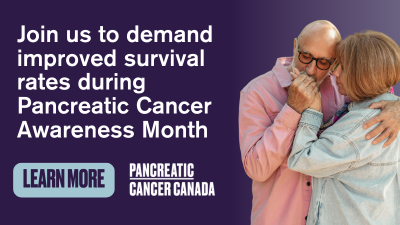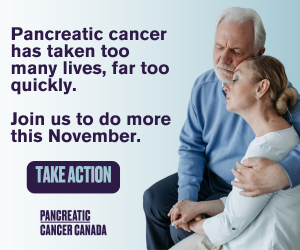The Facts
Each year, approximately 3,000 Canadians are diagnosed with brain tumours. A glioma is a type of malignant brain tumour. A malignant tumour is a mass of abnormal cells that is cancerous.
Tumours can develop in any part of the brain or its nerves and covering tissues. The two major types of brain tumour are primary and secondary. Primary brain tumours start in the brain. Secondary brain tumours start in another part of the body, then spread to the brain. A glioma is a primary brain tumour, accounting for 45% of cancers that begin in brain cells.
The three main types of glioma include: astrocytoma, ependymoma, and oligodendroglioma. Each of these types can be assigned a grade, either low grade or high grade, with high grade being more malignant and aggressive.
Astrocytomas are named for the cells where they originate, the astrocytes. These tumours can either show clear borders between normal brain tissue and the tumour (called focal) or no clear border (called diffuse). Focal astrocytomas are most common in children and are not often found in adults. Glioblastoma multiforme, is the most common and most aggressive astrocytoma.
Ependymomas begin in cells called ependymal cells that are found lining certain areas of the brain and spinal cord. These cells help repair damaged nerve tissue. They usually occur in children and young adults.
Oligodendrogliomas form in oligodendrocyte cells, which produce a fatty substance called myelin that protects the nerve. More common in adults, these tumours may move to other parts of the brain or spinal cord.
Causes
The cause of primary brain tumours is unknown. Some tumours tend to be hereditary so people who inherit specific genes may be more likely to develop a brain tumour. In other cases, a person's genes may change as they grow. Environmental factors such as food, radiation, or chemicals may cause these changes to genes.
Secondary brain tumours are caused by tumours in other areas of the body spreading to the brain.
Symptoms and Complications
A person with a brain tumour may experience various signs and symptoms of the condition. As the tumour grows, it puts pressure on the brain and its tissues. This pressure can affect the way the blood flows, as well as damage brain cells or cause swelling of the brain.
Common symptoms of a brain tumour include headaches and seizures. Other signs and symptoms, such as loss of speech or vision, are possible and depend on the location of the tumour.
Headaches may be dull and may cause a person to feel nauseated, to vomit or to have problems with their vision. The pain caused by the headache may increase as the tumour grows. It is also possible that such headaches will feel worse when a person is physically active.
A brain tumour may also cause partial or full seizures. The swelling or shrinking of a tumour may trigger this symptom.
If the tumour is located in the spinal cord, symptoms may include:
- chest pain due to a tumour located in the chest area of the spinal cord. The pain may increase when coughing, sneezing, or lying down.
- erectile dysfunction
- lack of ability to feel changes in temperature
- loss of muscle control
- loss of bowel or bladder control
- numbness or tingling
- pain in the arm, neck, back, or leg caused by tumours in the neck area of the spinal cord
- weakness in the limbs or upper body
Making the Diagnosis
Doctors use a number of techniques or procedures to determine if a person has a brain tumour. First, a doctor performs a physical examination and asks about the person's medical history. If a brain tumour is suspected, the person will likely be referred to a neurologist. The neurologist will likely perform neurological tests to determine how the nerves in the brain and spinal cord are working. Other tests used may include:
- blood tests
- chest X-ray
- computed tomography (CT or CAT) scan (if a tumour is present, it will show the location)
- magnetic resonance imaging (MRI) (not always performed)
- electroencephalogram (EEG)
- a tissue sample from the tumour to determine the type
For low-grade astrocytoma tumours, magnetic resonance imaging (MRI) is often the best way to see the tumour. High-grade astrocytoma tumours are best viewed with a CT scan. The grade of the tumour can also be determined by looking at the cells under a microscope.
If a brain tumour is diagnosed, the best method of treatment must be determined. It should be determined whether it is safe for the person to drive.
Treatment and Prevention
People with gliomas often receive a combination of different types of treatment for the best chance of recovery. Possible treatments include chemotherapy, radiation therapy, targeted therapies, and surgery.
Medications are useful in the treatment of glioma. Antiepileptic medications help reduce the risk of seizures. Chemotherapy, which uses a combination of powerful medications, helps damage or kill cancer cells. Unfortunately, chemotherapy medications also affect healthy cells in the body which may lead to side effects such as hair loss and vomiting. Corticosteroid medications may be recommended to reduce the swelling around a brain tumour.
Surgery is recommended in most cases to remove the tumour. The surgeon may decide to remove part of or the entire tumour depending on its location. If the tumour is on or close to the brain stem, surgery becomes more challenging. Surgery may also be done to relieve the pressure inside the brain.
Radiation therapy uses X-rays to destroy cancer cells in the tumour. Radiation therapy may damage healthy tissue around the tumour but doctors try to limit this damage as much as possible. Radiation can be done initially on its own, or if disease comes back after surgery.
Targeted therapies can be used to treat some forms of glioma. These therapies target and inhibit certain molecules which tell cancer cells to grow and divide. Just like many other cancer therapies, there can often be side effects, which vary depending on which targeted therapy drug is used. The most common side effects include:
- fatigue
- flu-like symptoms
- low blood cell counts
- nausea or vomiting
- skin issues such as rash
- vomiting
Some people also choose to enroll in a clinical trial for experimental medications or use complementary and alternative therapies (e.g., herbal preparations, reflexology, acupuncture, and Chinese medicine). Ask your doctor about what clinical trials are being offered that may suit your cancer treatment needs and what complementary therapies are available.
Generally, people choose to use complementary or alternative therapies along with the treatment recommended by their doctor.
To reduce your risk of developing different forms of cancer, make healthy choices every day. Some of these choices include:
- stopping smoking
- eating a healthy diet
- exercising regularly
- maintaining a healthy weight
- limiting alcoholic drinks
- reducing exposure to the sun's damaging rays and tanning beds
- minimizing exposure to chemicals and, if needed, handling chemicals safely and as instructed
All material copyright MediResource Inc. 1996 – 2024. Terms and conditions of use. The contents herein are for informational purposes only. Always seek the advice of your physician or other qualified health provider with any questions you may have regarding a medical condition. Source: www.medbroadcast.com/condition/getcondition/Glioma



